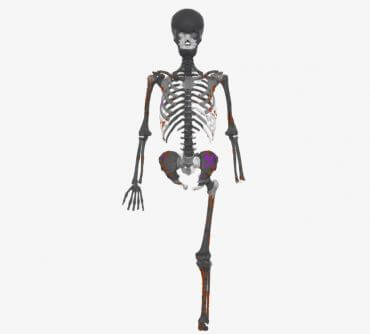
Original excavation photograph of Tsukumo No. 24, courtesy of the Laboratory of Physical Anthropology, Kyoto University. (CREDIT Kyoto University)
OXFORD, United Kingdom — Shark attacks are, statistically, one of the rarest ways a person can die. Worldwide, only about ten people are killed by shark attacks each year. Despite those odds, a recent study finds that’s exactly how a person met their end — 3,000 years ago. Researchers from the University of Oxford say they have discovered a human fossil whose remains suggest they died from a shark bite.
According to the team, the victim is the oldest, clear indication of a person killed by a shark. Professor Rick Schulting from Oxford University, and scholar J. Alyssa White, discovered the remains at Kyoto University during a separate study involving physical injury on the bones of archaic huntsmen. The two discovered “No24,” a mature man with several severe wounds, in the recently unearthed Tsukumo area.
“We were initially flummoxed by what could have caused at least 790 deep, serrated injuries to this man,” the Oxford pair says in a university release. “There were so many injuries and yet he was buried in the community burial ground, the Tsukumo Shell-mound cemetery site.”

“The injuries were mainly confined to the arms, legs, and front of the chest and abdomen. Through a process of elimination, we ruled out human conflict and more commonly-reported animal predators or scavengers.”
The ancient attack was horrific
Rather than relying on archaeology for answers, they examined the medical records of those that also died in shark attacks. They also looked to the expertise of shark researcher George Burgess, Director Emeritus of the Florida Program for Shark Research. A multidisciplinary team of scientists painstakingly reconstructed the horrific incident using various prehistoric research, along with forensic procedures.
The evaluation showed the person died between 1370 and 1010 BC — approximately 3,000 years ago. This is reinforced by the pattern of lesions on the bones. The victim’s left hand was severed as a result of self-defense. Additionally, the skeleton lacked a right leg and the left was turned backward and laid on the torso. This evidence indicates that someone else placed the victim’s remains in the gravesite following the attack.
“Given the injuries, he was clearly the victim of a shark attack. The man may well have been fishing with companions at the time, since he was recovered quickly. And, based on the character and distribution of the tooth marks, the most likely species responsible was either a tiger or white shark,” the study authors add.
“The Neolithic people of Jomon Japan exploited a range of marine resources… It’s not clear if Tsukumo 24 was deliberately targeting sharks or if the shark was attracted by blood or bait from other fish. Either way, this find not only provides a new perspective on ancient Japan, but is also a rare example of archaeologists being able to reconstruct a dramatic episode in the life of a prehistoric community,” concludes Dr. Mark Hudson, a Max Planck Institute researcher and co-author of the study.
The team published their findings in the Journal of Archaeological Science: Reports.









